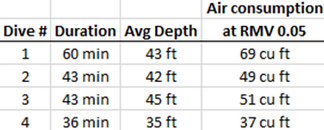Different computers don't change the amount of nitrogen you are being saturated with, they are offering different levels of "protection" to try to ensure that statically you can off gas safely with no ill effects. If you draw a line with getting a DCS on one side of it and being okay on the other, then how close you sail to that line is up to you. The simple fact is that we don't actually know where that line is, and the position changes not only between people but how a person is on that day.
I'm not trying to say people must dive a conservative computer, my point is that conservatism is more than just how many minutes at different depths.
Regarding the tables kindly posted by @scubadada, while I'm not going to criticise the way they do it because smarter people than I devised the test. It's a comparison rather than real world.
If I look at dive 1 parameters (time and depth) ignoring the 60min @15' (which I assume is to de-sat the computers) My very rough calcs scribbled on a bit of paper would suggest that a person would need a HP130 with a starting pressure of 3300psi and a SAC of 0.35 for them to surface near to 500psi (I worked it out in metric and used a converter so forgive me for inaccuracies. It's not exact but demonstrate what I mean. Even my calcs don't resemble real life as they don't allow for filling the BCD etc. My point is only a minority of single tank divers will manage this dive in theroy.
In practice a 1hr 46min dive, which is well off what the majority of divers would do regularly.
Lets play a game...
Using EANx 32% and a square profile dive to 100' what is considered an acceptable NDL by you personally
I'm not trying to say people must dive a conservative computer, my point is that conservatism is more than just how many minutes at different depths.
Regarding the tables kindly posted by @scubadada, while I'm not going to criticise the way they do it because smarter people than I devised the test. It's a comparison rather than real world.
If I look at dive 1 parameters (time and depth) ignoring the 60min @15' (which I assume is to de-sat the computers) My very rough calcs scribbled on a bit of paper would suggest that a person would need a HP130 with a starting pressure of 3300psi and a SAC of 0.35 for them to surface near to 500psi (I worked it out in metric and used a converter so forgive me for inaccuracies. It's not exact but demonstrate what I mean. Even my calcs don't resemble real life as they don't allow for filling the BCD etc. My point is only a minority of single tank divers will manage this dive in theroy.
In practice a 1hr 46min dive, which is well off what the majority of divers would do regularly.
Lets play a game...
Using EANx 32% and a square profile dive to 100' what is considered an acceptable NDL by you personally




